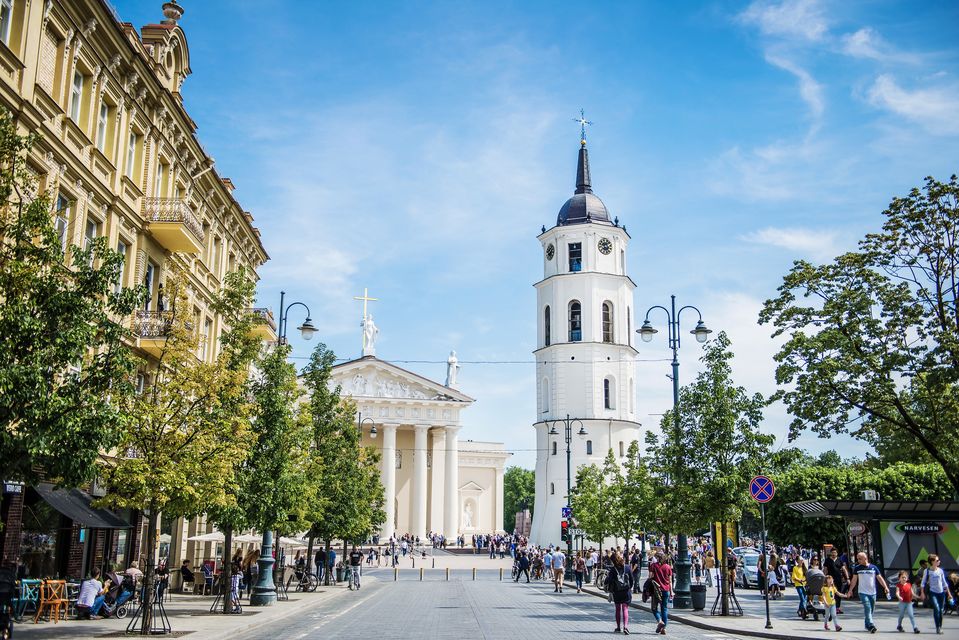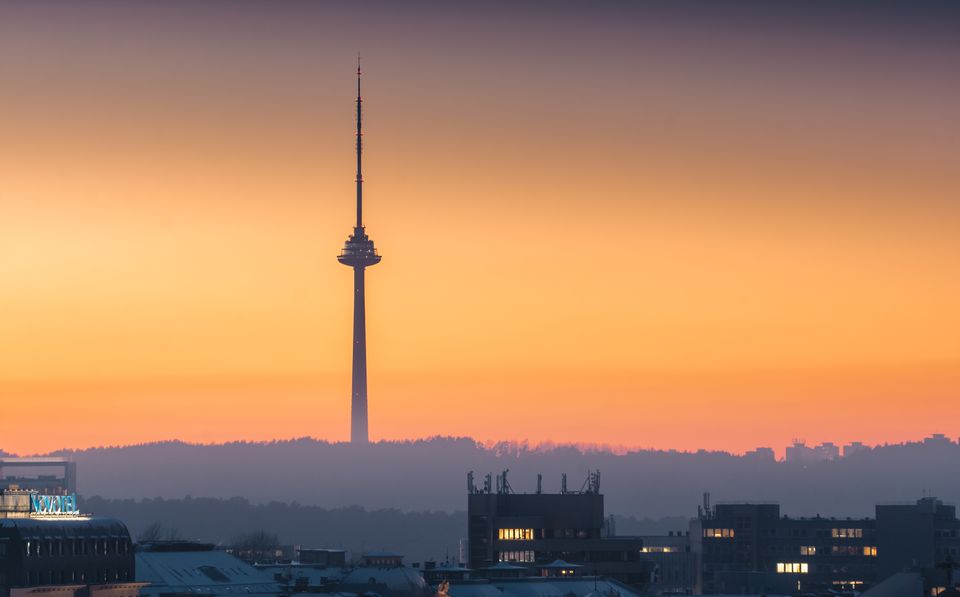Vilnius, Lithuania’s little-known capital, was recently named Europe’s cheapest city break
It is the final evening of my four-night trip to discover the delights of Vilnius – and undoubtedly the most unforgettable.
Valentas, a burly hot air balloon pilot, had moments earlier set fire to a few strands of my hair before extinguishing the flame with a splash of sparkling wine as he baptised me a ‘Duke from Trakai’.
The bizarre rituals take place at dusk in a deserted field beside a railway line on the outskirts of Lithuania’s compact capital, to mark the completion of my maiden airborne voyage in a wicker basket.
Balloon flights (from €150/£128pp) are a popular pastime here and have become synonymous with a city which last year celebrated its 700th anniversary.
My flight, signalling the start of the season, which runs from April until October, glides over the nearby lake resort of Trakai. Unlike most other European cities, accommodating government regulations also permit passengers to float directly above the historic old town.
Lake Galve is home to the fairytale-esque Trakai Castle. Photo: pA
If you splash €150 (£128) on a balloon flight, however, you will save money elsewhere.
Vilnius was recently named Europe’s cheapest city break in a survey of 37 cities by the UK’s Post Office Travel Money, which listed the average price of tourist staples like a cup of coffee at a cafe or bar for €2.11 (£1.80), a bottle of local beer for €3.22 (£2.74) and a three-course evening meal for two with a bottle of house wine for €69.43 (£59.60).
Still, despite direct Ryanair flights from Dublin Airport, it remains relatively uncharted territory as a short break – a reality readily acknowledged by locals.
“Please promise not to confuse the Baltics and the Balkans,” urges tour guide Lina Duseviciene, back on terra firma.
Frustration at Lithuania regularly being muddled with neighbouring countries is also expressed during my stay, while I am gifted a T-shirt by the tourist board emblazoned with the tongue-in-cheek slogan: ‘Nobody knows where Vilnius is.’
The nation was the first to declare independence from the Soviet Union, in 1990, and is the largest and most southerly of the three Baltic states.
Home to around 2.8 million people, it lies on the eastern shore of the Baltic Sea, south of Latvia, while also sharing borders with Poland, Belarus and the Russian exclave of Kaliningrad.
So, why should travellers venture through the Iron Curtain to this particular corner of Europe?
“Vilnius has an absolutely gorgeous landscape in the way it combines the city and nature in a very organic way,” says Lina during an informative stroll through the heart of her home town, which was added to the UNESCO World Heritage list 30 years ago.
“We are resembling many European capitals but in our own way.”
Vilnius’ neoclassical cathedral sits in the heart of the city. Photo: PA
In addition to natural beauty, I find tranquil Vilnius is suited to architecture enthusiasts, history buffs, gourmands and thrill-seekers alike.
We wander along cobbled streets flanked by Baroque buildings, through quaint university courtyards and in front of the presidential palace before arriving at the columns of the neoclassical cathedral.
High above us atop a green mound is Gediminas’ Tower – named after the city’s 14th century founding father and accessed by a funicular (€1 each way) or a steep climb (free).
The imposing landmark (entrance from €6) is the remnants of the Upper Castle and overlooks the confluence of the Neris and Vilnia rivers, the latter of which gave Vilnius its name, as well as the medieval centre.
Heading south, Lina leads us up Pilies gatve, the old town’s oldest street, past pavement cafes and the House of Signatories where, in 1918, the country’s act of independence was ratified.
Lithuania subsequently endured a turbulent 20th century, with brutal Nazi rule during the Second World War sandwiched between spells of Soviet repression.
Those dark days are detailed extensively in the Museum of Occupations and Freedom Fights (€6) and the recently-opened Museum of Culture and Identity of Lithuanian Jews (€3).
Vilnius’ Jewish population, known as Litvaks, was decimated from around 58,000 to less than 3,000 under Nazi command, a harrowing period commemorated by the city’s ghetto memorial at the end of Stikliu gatve.
Yet their culture, in a place Napoleon reputedly dubbed “the Jerusalem of the North”, continues to thrive.
Construction of Vilnius’ TV tower began 50 years ago and was completed in 1980. Photo: PA
I break up the educational but sombre museum visits by stopping for lunch at Baleboste (the term for an efficient Jewish housewife) next door to Hales Market, to sample customary Litvak cuisine.
Cutlery is not required as I join locals in dunking bagels into tasty bowls of shakshuka (eggs poached in a sauce of tomatoes, olive oil, peppers, onion and garlic, €9) and forshmak (herring mixed with egg and onion, €6) before chewing imberlach, a sweet, spicy confection made with ginger (E€5 per 100g).
Later, I visit Lokys, a family-run restaurant in the city’s medieval merchant house, to try the classic Lithuanian offerings of cepelinai (potato dumplings stuffed with ground meat, €15) and saltibarsciai (€8; lokys.lt/en).
The second dish, a cold beetroot soup served with potatoes and kefir (a fermented drink containing live bacteria and yeast), now has an Instagrammable annual pink festival held in its honour, with this year’s free event scheduled for June 1.
Eager for a mix of history and adventure, I travel to arguably the city’s most symbolic site.
Standing at 326.5 metres, Vilnius’ TV tower – the nation’s tallest structure – dominates the skyline in the western suburbs.
Tragic events here on January 13, 1991, when 14 civilians died while resisting an attempted Soviet coup, mean the tower is now forever etched in Lithuanian identity.
After spending time at the memorial wall commemorating those killed, a high-speed lift whisks me up 165 metres to the tower’s rotating viewing platform to be greeted by a glorious panorama.
I am swiftly given greater appreciation of my surroundings as I slip into a safety harness and step outside into blustery conditions to walk along the rim of the observation deck (€39 plus a €14 ticket to the open terrace).
Tethered from my back to a sliding clamp, I experience multiple seasons in the space of an hour as I tentatively circumnavigate in sunshine followed by cloud, rain and hail.
Ed Elliot ventured to the edge of Vilnius TV tower’s observation deck. Photo: PA
“Here it’s pretty windy so you can feel this adrenaline,” says youthful instructor Matas Ciuta, encouraging me to sit down and dangle my feet over the edge. “I like showing my city and this is the best view in Vilnius.”
It is difficult to disagree. But a matter of hours later comes the breath-taking balloon ride.
Shortly after take off, I gaze down from the gondola at a moose cow and two calves lumbering through a forest clearing in an ungainly fashion distinctly at odds with our calm drift.
At our backs the sun is slowly setting, while ahead are the pristine blue waters of Lake Galve, peppered with 21 islands, one of which contains the fairy tale-esque Trakai Castle.
Intermittent whooshes of liquid propane momentarily break the silence and warm our faces amid the cool evening air before Valentas brings us to ground with a slight bounce to begin his offbeat initiation routine.
The informal ceremony includes a concise history of ballooning, which originated in 18th century France and was initially considered an aristocratic pursuit, hence the bottle of fizz and my new noble title.
“Everything we flew above is yours now,” adds Valentas. “With one small condition: you have to be at least one metre from the ground.”
Tantalisingly within easy reach, the popularity of this small but impressive country is certain to soar.
News Catch Up: Wednesday 29th May 2024




